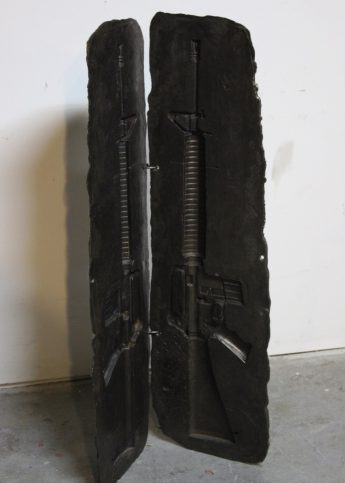Brooklyn-based multimedia artist Roberto Visani turns guns into art. His sculptures are loaded with historical, cultural and political commentary. They are compositions of many pieces assembled to tell stories of people and places. Each sculpture has its unique appeal, aesthetically and conceptually, and each speaks volumes…
Share your story with us. How did you become an artist? When did you know art was your calling?
I don’t know if I became an artist. I always was an artist, because my whole life I have been creative. I’ve always drawn. I’ve always built things and put things together. From early childhood, my parents sort of fostered that in me, either directly or indirectly because of what they wanted me to be and who they were. For me, there is a difference between what you do for a career and what your actual impulse is, so my natural impulse has always been to be an artist.
How would you define your art?
I don’t know if I want to define it. I like for work to define itself. That’s what I try and do when I resolve a piece. When I am in the studio, it is resolved when it defines itself as a work of art. I would hope that the audience recognizes that and not says “oh this is just a bunch of stuff put together” or “this just looks like colour,” or something like that but that it’s actually like “oh, the way these things are arranged together” or “the way these colours work with these lines, have meaning, communicate some kind of feeling or idea or pose an important question.” To me, that sort of idea of transforming everyday material or something that has one definition to something else is what art is about.
When and why did you start your “gun sculptures” project?
I started making guns in 1998/99. I was in West Africa and I saw some improvised weapons Africans had made during the colonial period and I just thought they were very interesting because they had talismans hanging off them or charms, and they had initials carved in them. They were these personal objects. They looked different than European weapons because they did not have the same sort of manufacturing process. I was talking to a friend and she mentioned that during the slave trade guns were traded for people and I thought back to those guns I saw at the Military Museum and that was really a powerful gesture to subvert that negative system of trade and to create something that would protect you and empower you in a very violent sort of environment.
Do you have a fascination with weapons?
I don’t think I have a fascination with weapons, no. I grew up with guns. I grew up hunting with my dad and I always thought of them as tools that had a particular purpose. I don’t have a stigma against guns but I am not a pro gun person either. I use them as a way to talk about social, cultural, historical issues surrounding them, whether it’s crime in inner cities, whether it’s imbalances in terms of economy and technology.
How do you alter the concept of a weapon to create art?
They are not guns. That’s where I start from. People that encounter my sculptures can usually tell right away that it is not literally a weapon. They can also tell that it refers to a weapon so a part of what happens is they combine the idea of a weapon with all the materials that it’s made out of or how it’s positioned, how it’s presented and that combination creates something else in their minds, creates some kind of understanding , some kind of questioning.
You recently opened an exhibition at Carol Jazzar Contemporary Art in Miami. What other exhibitions are planned for 2012?
I have an exhibition coming up in Rome, Italy, at a gallery called Monty e Company and that will be taking place in September of this year. People can also see my work on the website www.robertovisani.com and the website of Carol Jazzar has also some examples of my work
Words: Heike Wollenweber




